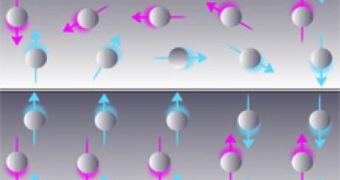Investigators from the University of Copenhagen's Niels Bohr Institute (NBI) announce an important breakthrough in the field of materials science – the creation of a material that is simultaneously magnetically and electrically polarizable.
Until now, this was thought to be impossible. Scientists believed that a material could be either magnetically polarized or electrically polarized, but not both at the same time. Recently, the Danish researchers have demonstrated that certain materials can be both at the same time.
What is remarkable about the new work is that the NBI team also developed a method of analyzing this class of materials, called multiferroics, down to the atomic levels. This was not possible in the 1960s, when Russian researchers first demonstrated that multiferroics were possible at all.
Details of the new research effort were published in the latest issue of the top journal Nature Materials. The team says that it focused its research on a specific iron compound, which occurs in nature. The material is however extremely rare.
“We have studied the rare, naturally occurring iron compound, TbFeO3, using powerful neutron radiation in a magnetic field. The temperature was cooled down to near absolute zero, minus 271 C,” explains UC Nano-Science Center associate professor, Kim Lefmann.
“We were able to identify that the atoms in the material are arranged in a congruent lattice structure consisting of rows of the heavy metal terbium separated by iron and oxygen atoms. Such lattices are well known, but their magnetic domains are new,” the expert goes on to say.
“Normally, the magnetic domains lie a bit helter-skelter, but here we observed that they lay straight as an arrow with the same distance between them. We were completely stunned when we saw it,” Lefmann adds.
What the new study did was enable the research team to figure out the relationship between the structure of the material and its physical properties in extreme detail. One of the phenomena that enables this magneto-electrical material is the interaction between iron, and the rare element terbium.
“What the models are describing is that the terbium walls interact by exchanging waves of spin (magnetism), which is transferred through the magnetic iron lattice. The result is a Yukawa-like force, which is known from nuclear and particle physics,” says Heloisa Bordallo.
“The material exhibits in a sense the same interacting forces that hold the particles together in atomic nuclei,” adds the expert, a NBI associate professor.

 14 DAY TRIAL //
14 DAY TRIAL //